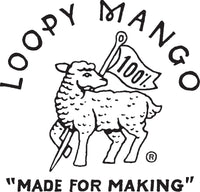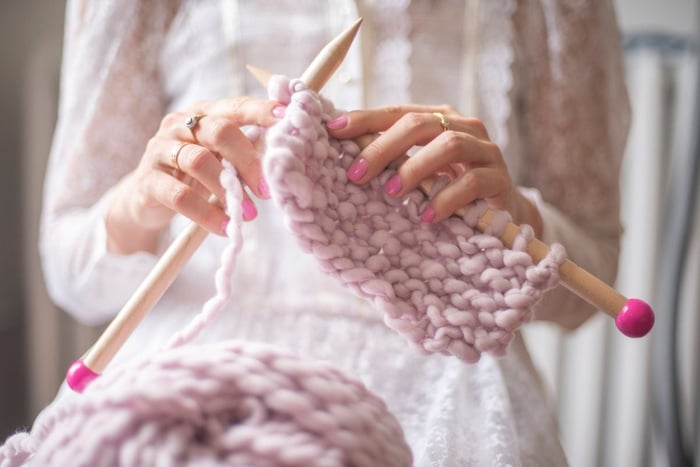Merino wool is well-loved by fiber enthusiasts worldwide — and with good reason! Named after the sheep that produce this wool, merino yarn is exceptionally soft, fluffy, and warm. It's also biodegradable and renewable!
We have two 100% merino wool yarns: Merino No. 5 and Dream. Both have all the delightful benefits of merino wool, plus a few fun features that make them unique to each other.
In this post, we'll cover:
- key characteristics that the yarns share, such as
- key differences between Merino No. 5 and Dream, such as
- what's different about the tweed variants of both merino yarns
- best fiber care practices for merino wool garments
Watch the following video to introduce yourself, then keep reading for even more info!
Key Characteristics
Fiber
Both Merino No. 5 and Dream are made from 100% merino wool*. Merino wool fibers are renowned for their extremely fine texture, which results in yarn that is exquisitely soft. Our merino yarns contain wool that is ethically sourced and come from non-mulesed sheep.
*Tweed variants have slightly different fiber content due to the nature of the yarn. Read more about this!
Merino wool is also easy to wear in any weather! When it's on the warmer side, merino has moisture-wicking properties to keep you cool. When the temperatures start to drop, the fibers will cling onto warm air to keep you cozy without weighing you down.
Natural fibers such as merino wool also have a huge advantage over synthetic fibers: They're biodegradable! Although most fibers will eventually biodegrade, the process is much quicker for natural fibers.
Ply
Both of our merino wool yarns' properties are most similar to single-ply yarn, in that they're fluffy, bouncy, and lightweight — which makes them both breathable and warm!
Unlike single-ply, Merino No. 5 and Dream have a second, thinner strand that's wrapped around the primary fiber. This strand serves two purposes:
- Stability: The extra structural support helps ensure that the yarn won't fall apart as you're working with or wearing it.
- Texture: The extra strand provides visual and tactical interest without sacrificing any of the benefits of single-ply.
Drape
Drape refers to how the fabric of a garment hangs on the wearer's body. Merino wool fibers, especially as configured in our yarn, are particularly lightweight. That means that projects made from Merino No. 5 and Dream will drape a bit differently than one made from one of our cotton yarns. Let's look at a few examples of this:
In the Easy Vest, the difference between merino wool and cotton is subtle, but definitely noticeable! Look closely at the stitch definition in each version: The Big Cotton style hangs a bit more heavily, giving the seed stitch a more open feel, while the Merino No. 5 edit looks lighter and bouncier. Neither is better than the other, but they are certainly different!

The same thought applies to lighter weight yarns. Notice how the brioche stitch in the Summer Brioche Sweater has a weighty, almost stretchy drape, while its Dream counterpart maintains a more defined, boxy silhouette.
Key Differences: Merino No. 5 vs. Dream
Though they are both made from merino wool, Merino No. 5 and Dream have a few distinct qualities that set them apart from each other. Most prominently:
- Weight Category
- Weight and Yardage
- Ideal Needle/Hook Size
Weight Category
The thickness of a yarn is sometimes referred to as its weight category. This is perhaps the biggest difference between our two merino yarns.
Merino No. 5 is a super-bulky yarn, averaging 3–5 wraps per inch.
Dream is a worsted yarn, averaging 8–10 wraps per inch.
In simpler terms: Merino No. 5 is much thicker than Dream!
Weight and Yardage
Looking at a ball of Merino No. 5 next to one of Dream, it's apparent that they are not the same size — but just how different are they?
A ball of Merino No. 5 weighs 150 grams and includes 74 yards of yarn.
A ball of Dream, conversely, weighs 50 grams and includes 109 yards of yarn.
Ideal Needle/Hook Size
Whether knitting or crocheting, the size of the tools used will affect the finished fabric. The thought behind this is fairly straightforward: Smaller needles/hooks will result in a tighter stitch, and larger needles/hooks will result in a looser stitch. Due to the differing weight categories between Merino No. 5 and Dream, they're each better suited to a different size range of tools:
- Merino No. 5 works up best with needles/hooks that are between 10mm and 25mm
- Dream works up best with needles/hooks that are between 4.5mm and 15mm
What about Tweed?
 Both Merino No. 5 and Dream are available in multiple gorgeous tweed varieties. Adorned with beautiful little flecks of color, these yarns add a nice sense of dimension to any handcrafted project.
Both Merino No. 5 and Dream are available in multiple gorgeous tweed varieties. Adorned with beautiful little flecks of color, these yarns add a nice sense of dimension to any handcrafted project.

These aforementioned little flecks cause the slight deviation in fiber content, resulting in the following breakdown per ball: 80% merino wool, 14% wool, and 6% viscose. (Viscose is very similar to rayon, both semi-synthetic materials that are often used as a more sustainable alternative to other synthetics.)
Fiber Care: Merino Wool
Regardless of method, we always recommend test-treating a small swatch to make sure you like the result before treating a finished garment.
Superfine merino fiber is considerably delicate — that's why it feels so soft against your skin! — so it's important to treat a garment made from Merino No. 5 or Dream carefully.
Exposing wool to heat or agitation will cause it to shrink and felt, which means your merino yarn treasures should stay far, far away from the washing machine.
In fact, less is usually more when it comes to garments made from our merino yarn. Wool fibers contain self-cleaning properties (derived from natural oils within the fiber) that prevent odors from clinging to the fabric.
If you do find yourself needing to clean a merino garment, we recommend dry cleaning or hand washing cold and laying flat to dry. Again, test any method on a swatch first!
Some shedding is possible, especially with super-bulky merino yarn like Merino No. 5. This often appears as "pills," or small balls of wool that stick out from the fabric. Check out our tutorial on an easy way to de-pill your handmade knit and getting it looking like new again!



